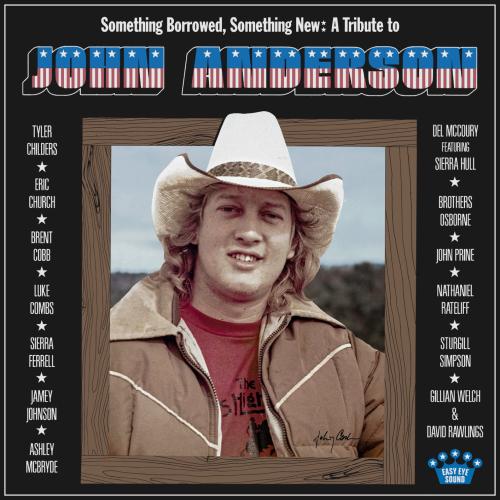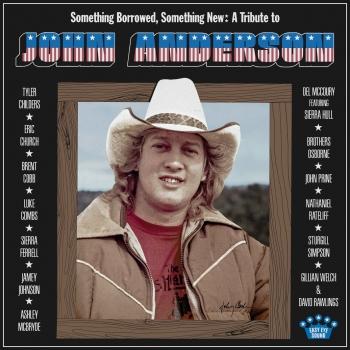
Something Borrowed, Something New: A Tribute to John Anderson Various Artists - John Anderson
Album Info
Album Veröffentlichung:
2022
HRA-Veröffentlichung:
05.08.2022
Label: Easy Eye Sound
Genre: Country
Subgenre: Traditional Country
Interpret: Various Artists - John Anderson
Das Album enthält Albumcover
Entschuldigen Sie bitte!
Sehr geehrter HIGHRESAUDIO Besucher,
leider kann das Album zurzeit aufgrund von Länder- und Lizenzbeschränkungen nicht gekauft werden oder uns liegt der offizielle Veröffentlichungstermin für Ihr Land noch nicht vor. Wir aktualisieren unsere Veröffentlichungstermine ein- bis zweimal die Woche. Bitte schauen Sie ab und zu mal wieder rein.
Wir empfehlen Ihnen das Album auf Ihre Merkliste zu setzen.
Wir bedanken uns für Ihr Verständnis und Ihre Geduld.
Ihr, HIGHRESAUDIO
- 1 1959 03:22
- 2 Years 02:59
- 3 Wild And Blue 03:06
- 4 Low Dog Blues 03:47
- 5 Mississippi Moon 04:05
- 6 I Just Came Home To Count The Memories 04:06
- 7 Shoot Low Sheriff! 02:34
- 8 Seminole Wind 04:38
- 9 When It Comes To You 03:50
- 10 You Can't Judge A Book (By The Cover) 03:03
- 11 Would You Catch A Falling Star 02:42
- 12 Straight Tequila Night 03:23
- 13 I’m Just An Old Chunk Of Coal (But I’m Gonna Be A Diamond Some Day) 03:16
Info zu Something Borrowed, Something New: A Tribute to John Anderson
Eine Hommage an die Country-Musik-Legende John Anderson!
Beiträge von Luke Combs bis John Prine, von Eric Church bis Tyler Childers, Nathaniel Rateliff bis Brothers Osborne, und Ashley McBryde bis Gillian Welch & David Rawlings und viele mehr!
Es gibt Giganten, die unter uns wandeln. John Anderson ist wahrlich eine Country-Legende, denn seine bemerkenswerte Karriere erstreckt sich über mehr als 40 Jahre, von 1977 bis zu seiner letzten Veröffentlichung Years, die von Dan Auerbach im Jahr 2020 produziert wurde. In dieser Zeit hat Anderson mehr als 40 Singles in den Billboard Country Music Charts platziert, darunter beeindruckende fünf Nummer-eins-Hits in mehreren Jahrzehnten. 2014 wurde Anderson in die prestigeträchtige Songwriters Hall of Fame gewählt. Der Einfluss, den er im Laufe seiner Plattenkarriere ausübte, ist inzwischen legendär.
Während der Aufnahme von Years für Easy Eye Sound begannen namhafte Künstler - von Gleichaltrigen bis hin zu Beeinflussten - sein Werk zu loben. Aus diesen vielen Begegnungen entwickelte Dan Auerbach die Idee einer Hommage an das Genie von John Anderson. Von Luke Combs bis John Prine, von Eric Church bis Tyler Childers, von Nathaniel Rateliff bis zu den Brothers Osborne, von Ashley McBryde bis zu Gillian Welch & David Rawlings und vielen anderen kamen die größten Talente zusammen, um John Anderson und seinem Werk Tribut zu zollen.
John Anderson
Hoeing orange trees was less than ideal, and so John Anderson took a gig as a plumber’s helper. The pay was alright and the work was steady, but music pulled at Anderson’s 17-year-old heart, and you had to be 21 to play, sing, or drink in Central Florida honky-tonks. Anderson left his home — a magical kingdom until Walt Disney put Cinderella’s Castle on the land that God meant for fathers and sons to hunt turkeys together — and headed 700 miles northwest, to Nashville.
It was the summer of 1972, when songwriting legends walked the streets and pounded the pinball machines. Anderson wanted in, even if it meant living on wages that didn’t provide for essentials like bait and shotgun shells. He took a job as a construction laborer, working on a newfangled building called the Grand Ole Opry House.
Not long after taking the job, he got a raise: They raised him up to the roof, where he thought about how the Nashville wind blows cold and where he stared down at a big, deep hole, with rebars sticking up. That hole would soon become a stage, and that stage was where Anderson wanted to be.
Turns out, he made it. It was holy hell, but he made it to the Opry stage and far beyond. He made it with a voice that was traditional enough to make Emmylou Harris wonder if Anderson might be a distant relative of Lefty Frizzell, yet that was, and is, instantly identifiable. He made it with original music that landed him in the Nashville Songwriters Hall of Fame, and with radio hits including chart-toppers “Swingin,’” “Straight Tequila Night,” “Wild and Blue,” “Black Sheep,” and “Money in the Bank.”
Before Ricky Skaggs, George Strait, and Randy Travis were household names, John Anderson was Nashville’s young and hard-charging traditionalist, devoted to extending the legacies forged by Haggard, Jones, and Cash, and loathe to compromise when he knew he was right. And, when it came to making music, he knew he was right.
“Back then, it seemed like there wasn’t a whole lot of real country music, the way I think of it,” Harris said. “Then along came John Anderson: John was doing this, and he was all by himself.”
Anderson signed with Warner Bros. in 1976, and set about making music that would gain notice from legends. Haggard heard him early on, and invited him on the bus for a heart-to-heart.
“He said his guitar player, Roy Nichols, brought him a 45 of ‘Your Lying Blue Eyes,’ Anderson remembers. “He said, ‘I’ve loved you ever since.’ But then he looked me in the eye and said, ‘Do you love this, son?’ ‘Yessir, I really do.’ No, do you really, really love it.’ I said, ‘Yessir. Hell, I’m talking to Merle Haggard and I can’t really stand myself right now, but I really love it.’ We went on to to 40 years of being buddies, Me and Merle.”
At the time “Your Lying Blue Eyes” came out, Anderson was playing with house bands around the South. The song became his first Top 20 hit, and soon the name “John Anderson” on a roadside club sign was enough to fill up a parking lot with Trans Ams and pickup trucks. A string of hits ensued, with “1959,” “Chicken Truck,” “I Just Came Home To Count the Memories” and “Would You Catch a Falling Star” leading up to his breakthrough, the John Scott Sherrill-penned “Wild and Blue.” That song was the title track of an album that included Anderson’s first million-selling single, “Swingin,’” written with old friend and running partner Lionel Delmore.
Dieses Album enthält kein Booklet










